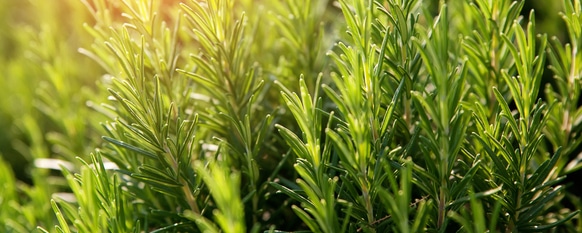The herb of remembrance, rosemary, is easily recognized by its woody stems and narrow, needle-like evergreen leaves with a silvery underside. Born in the Mediterranean area and used by the ancient Greeks and Romans, this herb needs growing conditions similar to its native home: dry, slightly acidic soil, temperatures above freezing, and full sun.
Rosmarinus officinalis – “dew of the sea” – is a member of the mint family and is hardy in USDA zones 7 through 10. In colder climates, this herb is best grown as an annual, but it can be overwintered indoors. As an iconic center of the herb garden, it is often showcased as a topiary in a large terra cotta pot.
In addition to herbs, we also recommend that you consider growing other vegetables such as growing a squash plant.

Types of Rosemary
There are two types of rosemary – varieties that have been developed to use as landscape plants and varieties that are better for culinary uses.
Varieties developed for landscaping are a perfect choice for gardeners in zones 7 through 10 who wish to create a Mediterranean style garden. These plants are good for rock gardens, gravel gardens, seaside gardens, or xeriscapes. They blend well with plants such as lavender, nepeta, and salvias. And these plants are also edible. Here are a few to try:
- Tuscan Blue can grow between 36 and 60 inches tall and wide and has light blue flowers.
- Arp can be hardy to zone 6 if grown in a sheltered area. It gets 48 inches tall and has purple flowers.
- Irene has a trailing habit and makes a good groundcover. It grows 12 to 18 inches high and 18 to 36 inches wide with purple flowers.
Varieties that are a good choice for a cook’s herb garden include:
- Blue Boy, a dwarf variety, is perfect for containers as it only gets 6 to 8 inches tall and 15 to 18 inches wide
- Spice Islands has exceptional flavor and can get 6 feet tall and wide in areas where winter temperatures stay above freezing.
- Albus sports very fragrant, tiny, white flowers and can grow to 4 feet tall.
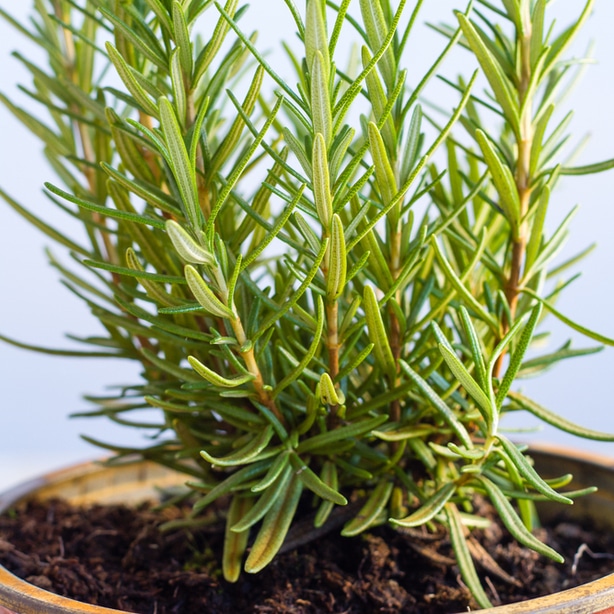
Growing Guide
Planting Outdoors
Plant rosemary in a full sun location that gets 6 to 8 hours of sunlight per day. Plant in the spring, after the danger of frost has passed. In zones 7 through 10, where it will survive the winter, you can also plant in the fall. Plant in a well-draining soil, and if grown in containers, it will need a gritter, leaner potting mix rather than one high in organic matter and fertility. A potting soil designed for cacti and succulents would work well here.
We recommend using starter plants from the garden center. Rosemary seeds have very low germination rates, and it can take up to a year and a half for a plant grown from seed to reach a harvestable size. If you start it from stem cuttings, it will only take a year until it is ready to be harvested.
Plant the culinary varieties about 2 feet apart; landscape variety spacing depends on the particular cultivar’s mature width. A variety that grows to 3 feet wide will need about 4 feet of space. Rosemary needs good air circulation around the plants to avoid fungal diseases such as mildews and rots.
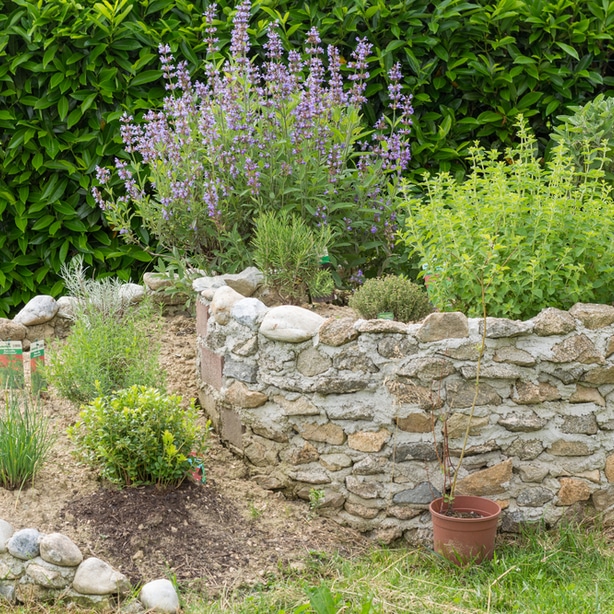
Watering
This is a plant that prefers dry conditions. Water deeply after planting and then check your plants every few days until established – about two weeks. During this time, water when the top inch of soil is dry. After that, it will need very little supplemental water and will survive periods of drought. Water every week or two during droughty times. Otherwise, rosemary does just fine with what nature gives it.
Fertilizing
Rosemary doesn’t need a lot of fertilizer and can get through the summer without any fertilizer at all in most cases. If your plant looks a little yellow or stunted, you can fertilize with a balanced 10:10:10 liquid fertilizer every two weeks. A heavy fertilizer schedule can increase new growth, but can also lead to insect problems. Insects that suck plant juices such as aphids and spider mites are attracted to the tender new growth that high nitrogen fertilizers encourage.
Growing in Containers
The size of the pot you use should be as big as the plant. If your plant is 6 inches high and wide, grow it in a 6-inch pot. A terra-cotta pot is a good choice as the clay wicks excess moisture from the soil. As your plant matures, you can repot it in a larger pot, or you can prune the roots to keep it the size you want. Rosemary hates “wet feet,” so be sure the pot has a drainage hole. You can fill the saucer with pebbles to lift the pot above any water that drains through it. This helps prevent root rot.

Making a Topiary
Rosemary is often grown in containers as a small ball-shaped tree, called a topiary. This process may take a few years, but it can be a fun and rewarding DIY garden project. To train your plant into a topiary:
- Select one long, strong center stem and cut all the other stems away at the base of the plant.
- Strip the leaves from the stem about halfway up and snip the growing tip. Cut off about an inch or two; the plant will branch out from there.
- Stake the plant to encourage it to grow upright.
- Over time, continue cutting back the growing tips to encourage more branching, and continue to cut the lowest stems from the main stem until your plant reaches the height you like.
- Snip the green top growth into shape. A ball is traditional, but it can be any shape you like.
- Once the stem has become woody and can support itself, you can remove the stake,
- When harvesting, trim sprigs to maintain the shape.
Growing Rosemary Indoors
This herb requires different care when grown as an indoor plant. It still needs full sun, but your watering methods will change. When grown outdoors, rosemary gets a lot of the moisture it needs from humidity in the air.
Dry indoor air, especially in winter, can make growing rosemary indoors challenging. To give the plant more moisture to pull from the air, place the pot on a saucer or tray of pebbles and keep the pebbles wet to increase the humidity around the plant. Mist the leaves a few times a week, and only water when the soil is completely dry.
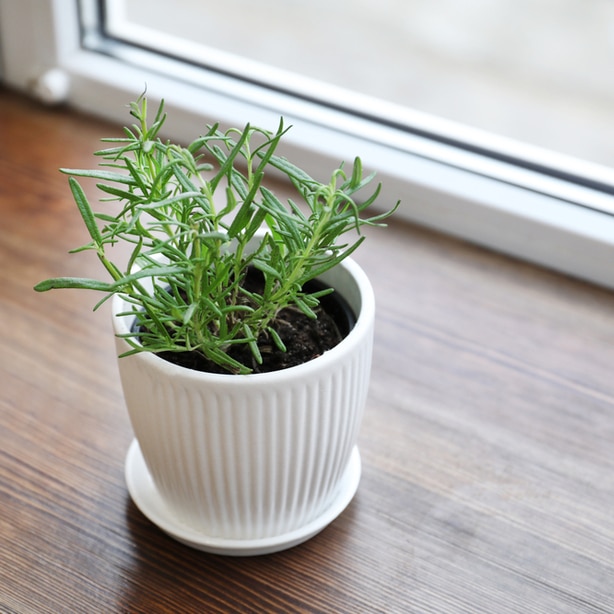
5 Extra Tips for Growing Success
- Rosemary likes lean, dry conditions and positively thrives on benign neglect. So don’t overwater, and don’t over-fertilize.
- This herb’s leaves do not wilt, so don’t rely on wilting as an indication of water needs.
- Feel the soil and only water when the soil is completely dry all the way down to the roots.
- It’s okay to let this herb flower: flowers do not affect the taste of the leaves like some other herbs. They have a pretty fragrance and are attractive to pollinators.
- Pruning will help keep your plant from getting too woody and encourages fresh new leaves.
Companion Planting
Plant rosemary with other herbs from the Mediterranean area that flourish in the same conditions – sage, lavender, oregano, thyme, and marjoram all make good herb companions. It’s a good companion for some vegetables, too. Try planting it with beans, carrots, broccoli, hot peppers, and cabbage. Companion planting is said to increase plant health and yields.

Pests and Diseases
Root rot is the most common problem that affects rosemary and can be avoided by watering properly. Fungal diseases such as powdery and downy mildew can be avoided by ensuring good air circulation around the plants, so don’t place your plants too close together.
Aphids and spider mites are the insect problems you might encounter. They can be controlled with a strong blast of water from your garden hose or with an insecticidal soap approved for use on food crops.
Harvesting
When your plant is big enough, you can harvest at any time during the growing season. Don’t take off more than one-third of the plant at any one time. Leave it enough top growth for photosynthesis. Harvested sprigs that are between 2 and 4 inches long work well for cooking. You can use the sprigs whole or strip off the leaves.
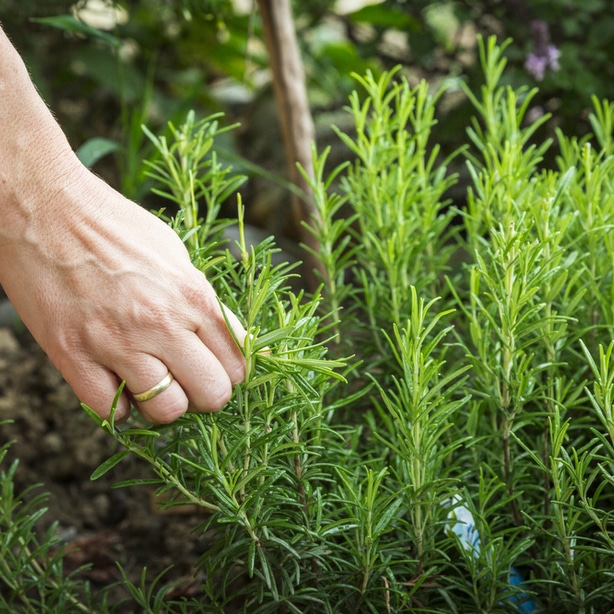
Drying and Storing
Harvested sprigs can be frozen in ice cube trays in water or olive oil. They can also be frozen on a sheet pan, then transferred to a freezer bag.
Rosemary can be air-dried or dried in a low-temperature oven. A common method to air dry them is to bundle herbs into bouquets that are hung upside down in a well-ventilated room out of direct sunlight.
Once dried, store the sprigs in an airtight container in a cool, dry place. They should last about 6 months. Once dried herbs lose their aroma, it’s time to replace them.
Uses
Its pungent sagey-citrusy flavor makes rosemary a popular herb for use in soups, stews, and bread and is often paired with lemon in fish and chicken dishes.
Make an herbed salt by mixing 3 cups sea salt with ½ cup dried, cracked rosemary. Use on fresh tomatoes, eggs, chicken, or roasted vegetables.
Vinegar can be infused with rosemary. Mixed with other herbs or with garlic and orange zest, and allowed to age. Herbed vinegar can add a bright dimension to salad dressings and other recipes.
Rosemary is often used medicinally for stress and pain relief, and for hair loss. It is used in aromatherapy, as a massage oil, and is a popular ingredient in potpourri.
And did you know? Ancient Greek and Roman scholars wore wreaths of rosemary on their heads because it was said to improve memory. Recent studies suggest its fragrance might help people retain information, but that has not has been proved conclusively. It’s just something you will have to try for yourself.

